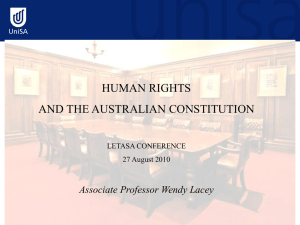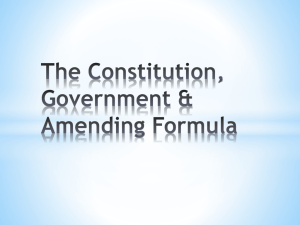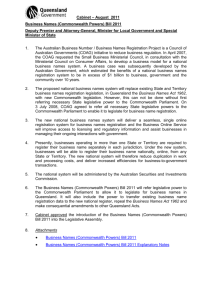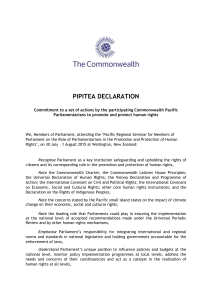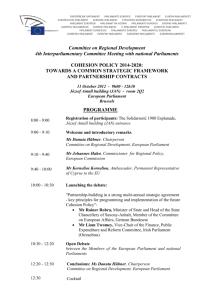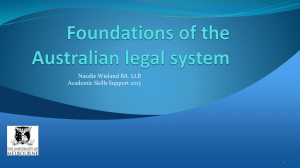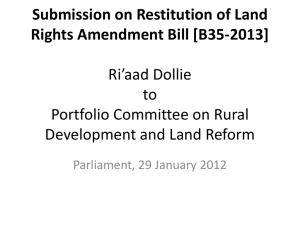FDNLaw4e_slides_ch02 - Tilde Publishing and Distribution
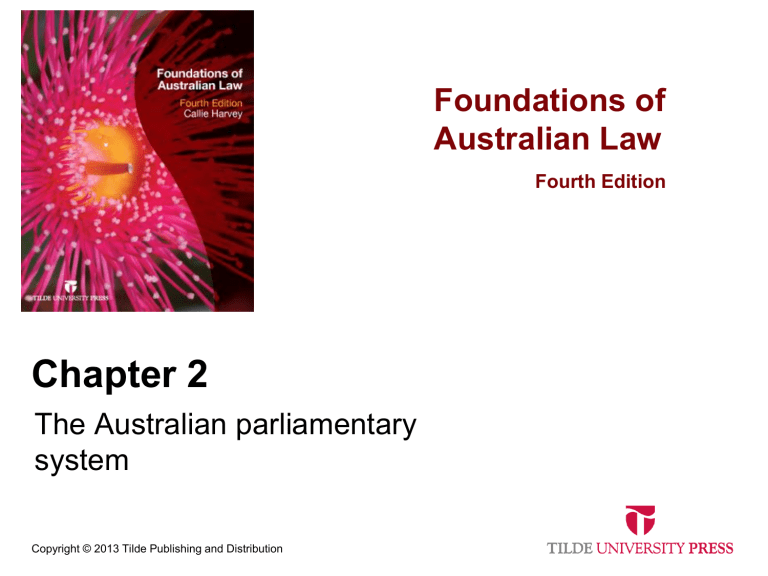
system
Copyright © 2013 Tilde Publishing and Distribution
Foundations of
Australian Law
Fourth Edition
Chapter overview
This chapter looks at the concepts of
The Australian Parliament
State parliaments
Separation of powers
Representative and responsible government
Limitations on powers
Legislation, Bills and Acts
Parliament
• Supreme law making body derived from the
British Westminster System
• Supreme position of parliament is referred to as sovereignty of parliament
• Australia has a national Federal Parliament as well as state and territory parliaments.
Australian parliaments
• Commonwealth Parliament - Canberra
(bicameral)
• ACT Parliament (unicameral)
• NT Parliament (unicameral)
• Queensland Parliament (unicameral)
• NSW Parliament (bicameral)
• Victorian Parliament (bicameral)
• Tasmanian Parliament (bicameral)
• South Australian Parliament (bicameral)
• Western Parliament (bicameral)
Parliamentary system
• Parliament is comprised of one or two houses
• A house is an assembly of elected members of parliament
• Bicameral parliamentary system
two houses
• Unicameral parliamentary system
one house
British Westminster system
• Head of State
Queen Elizabeth II
• Lower House
House of Commons
• Upper House
House of Lords
Main functions of parliament
• Form government
• Enact and abolish laws
• Establish committees to investigate issues of concern and scrutinise the government in power
History of Australian Federation
• Federal Council of Australasia Act
1885 passed to allow the colonies to confer every two years and pass laws of common interest
Historical timeline
Late 1800s
1891 -1898
Idea of an Australian Federation was born
A number of conventions were held to draft the Australian Constitution
1899
The Commonwealth of Australia
Constitution was passed to form the
Commonwealth of Australia
The colonies formed six states and two territories
1901
Lord Hopetoun was appointed as
Australia’s first Governor General
Commonwealth Parliament
• Commonwealth of Australia
Constitution Act 1900
referred to as the Commonwealth
Constitution
• Constitution
established Commonwealth
Parliament
set out the law making powers between the Commonwealth and the States
Commonwealth Parliament
• King or Queen (i.e. the Crown)
• Upper House
Senate
• Lower House
House of Representatives
C’wealth Government
• Government
political party in power
• Prime Minister
head of the government
Cabinet
• Cabinet comprised of senior and junior ministers
Senior ministers in charge of important portfolios
Junior ministers in charge of less important portfolios
Cabinet functions
• Constructing policy
• Approving bills
• Prioritising bills for introduction to parliament
• Senior ministers supervise the administration of their respective government departments
Executive Council
• Consists of
Governor General
Prime Minister
Ministers in Cabinet
• Role is to formally ratify decisions made by the ministers in relation to administration of government
Opposition
• Party with the next largest number of seats
State & territory parliaments
• Structure
King or Queen
Upper House
- usually called Legislative Council
Lower House
- usually called Legislative Assembly
State & territory governments
• Leader of the governing party
Premier of that state
• State parliaments have cabinets,
Ministers, and Executive Councils
• Executive Councils called
Governors in Council in all states and territories
Parliaments
Separation of powers
Separation of powers
• Law-making powers exercised within society can be classified in three ways
legislative power
executive power
judicial power
Legislative power
• Given to Australian parliaments by the Commonwealth Constitution to make legislation
Executive power
• Power to administer laws
• Exercised by
Executive Council in the
Commonwealth of Australia
Governor in Council in all states and territories of Australia
Judicial power
• Power exercised by the Courts
• Involves
hearing and determining legal questions
interpreting the law and its application in particular cases
Representative Government
• Every member of each parliament in
Australia represents the people within the electorate that elected that member
• Every Member of Parliament is answerable to his/her electorate
• If majority of voters in an electorate are dissatisfied with the local member/local member’s political party, a new person may be elected to represent that electorate in parliament
Powers of parliament
• Constitution divides the legislative powers between the Commonwealth and the states
Powers of Commonwealth
Parliament
• Constitution has given the
Commonwealth Parliament the right to exercise specific powers
• Two categories of specific powers
Exclusive
Concurrent
Exclusive powers
• Constitution has allocated the
Commonwealth Parliament exclusive powers to legislate in particular areas
• Allow only the Commonwealth
Parliament to make laws in areas that affect the nation
Exclusive powers
• S114 – the raising and maintaining of any naval or military force
• S 115 – the coining of money
• S 90 – the granting of bounties on the production or export of goods
• S 52 (ii) – the Commonwealth
Public Services
Concurrent powers
• Shared between Commonwealth and state parliaments
• Allow both parliaments to legislate in the same areas such as quarantine and taxation
Concurrent powers
• S109 of the Constitution provides that where a state law is inconsistent with a
Commonwealth law the later will stand
• Commonwealth laws always prevail over state laws
Residual powers
• Given to state parliaments to make laws in relation to state matters
roads, railways, hospitals etc
• Powers are not specifically stated in the constitution but are left over powers
Limits on
Commonwealth power
• Limited by the Constitution
• Commonwealth
must not prefer one state over another in relation to trade, commerce or revenue (s 99), or in relation to taxation (s 51(ii)) must protect every state against invasion (s 119) cannot restrict free trade between states (s 92)
Limits on state powers
• Limited by the Constitution
• States
cannot levy customs & excise duties (s 90)
trade between states must be free (s 92) prohibited from raising military forces (s 114)
prohibited from coining money (s 115)
• Federal law will always prevail over state use of a concurrent power to the extent of any inconsistency (s 109)
Overcoming constitution limitations
• The Commonwealth may overcome its constitutional limitations in two ways
making an agreement with states
change the constitution
Agreement with the states
• S 51 (xxxvii) of the Constitution allows state parliaments to refer a residual power to the Commonwealth in relation to passing legislation in a particular area
• S 61 of the Constitution allows the
Commonwealth to give the states funds to spent in a particular way, e.g. maintenance of roads
• Encourage all the states to enact the same legislation in a particular area thus uniforming the law
Changing the constitution
• The Constitution may be changed in two ways
Referendum method
High Court method
Referendum method
• Section 128 of the Constitution allows itself to be changed only in accordance to the process of a referendum
• A referendum allows wording of the
Constitution to be changed through adding, deleting or amending words, sentences or sections
High Court method
• High Court
Does not change the words of the Constitution
It ’s role is only to interpret its words
Resolves disputes between the Commonwealth and a state
Its interpretation of particular sections of the
Constitution may alter the balance of power between the states and the Commonwealth
• See Franklin Dam Case on page 50
Delegated legislation
• Parliaments delegate some of their law making powers to expert bodies to make laws in their specialised areas
• Expert bodies known as subordinate authorities
• Laws made by these bodies are referred to as delegated legislation
How are law making powers delegated?
• By way of an enabling act or a parent act
• Enables a subordinate authority to make laws in the form of regulations, by-laws, orders, statutes, and/or rules
• Sets strict guidelines to be followed by the particular subordinate authority
Ultra vires
• Regulations passed by subordinate authorities that are beyond the powers granted by parliament can be challenged as being ultra vires
( ‘beyond power’)
• Regulations declared ultra vires are not enforceable
Examples of bodies that make delegated legislation
• Subordinate authorities
local governments government departments
Executive Council
• Statutory bodies
educational institutions public utility corporations administrative tribunals some courts sporting & other public purpose institutions
Advantages of delegated legislation
• Subordinate authorities
have more time, in comparison to
Parliaments, to make laws
have more expertise (especially local)
can take swifter action
allow greater public participation through the empowerment of local authorities
Disadvantages of delegated legislation
• Laws and regulations are made by unelected public officials
• Quality of checks on subordinate authorities can at times be questionable
• Subordinate authorities may at times infringe upon basic human rights
• Use of subordinate authorities may contribute to over-government and the fragmentation of law-making
Checks on delegated legislation
• Main methods of checking
committee system
parliamentary supervision through tabling
Legislative process
• Refers to the law making by which parliaments make Acts
• Commonwealth and state
Parliaments have the same legislative process
Tabling of proposed law
• The Minister advises one of the
Houses of Parliament of the issues raised in the report to place it before the House
called tabling
Policy
• The Minister prepares a number of policies based on the recommendations made in the report
• Cabinet consider and debate the proposed policies and decide whether government should legislate the policy
• If Cabinet decides to adopt the policy, usually the
Minister would announce that policy
Drafting a Bill
• Cabinet instructs Parliamentary Counsel to prepare a draft of the proposed legislation
• Proposed legislation is referred to as a Bill
• The draft Bill must receive the approval of the party before it can be processed through Parliament to become law
Houses of parliament and law making
• The house in which the bill is initiated called the House of Origin
• House of Origin - usually the Lower House
• Once the bill approved by the House of
Origin it proceeds to the opposite house to be examined and scrutinised
• This house is called the House of Review usually the Upper House
• Names of the houses vary according to the level of parliament
House of Origin
• The bill begins the legislative process in the House of Origin by progressing through stages
initiation first reading second reading third reading
Initiation
• Relevant Minister advises the Clerk of that House that he/she intends to introduce a Bill
• Clerk then lists the Bill for its first reading in the House
First reading
• Permission is granted to introduce the Bill to the House
In Commonwealth Parliament the Clerk reads out the Bill’s long title
In state parliaments the Minister introducing the Bill reads out the Bill’s long title
• No debate takes place during this first reading and a date is allocated for the second reading of the Bill
Second reading
• Members of the House of Origin are given a copy of the Bill
• The Minister identifies the general purposes and effects of the Bill
• Debate may then take place dealing with any issues relating to the Bill
• House votes on whether the Bill will be read a second time
• If the vote is in favour, the clerk reads the
Bill’s long title for a second time
Committee stage
• If the House wishes to examine the Bill in more detail, the Bill enters Committee Stage
• Committee Stage takes place in one of the following forms:
a committee of the whole – where all Members of the
House consider in detail each of the Bill’s clauses and make any necessary amendments
a select or standing committee - the Bill is referred to a committee of some of the Members of the House which then considers the Bill in detail and makes any necessary amendments
Committee stage
• The committee makes a report on its progress to the House
• The House may then either
consider the Bill further at the committee stage, or
the Bill may pass to the third reading
Third reading
• Minister moves a motion that the Bill be read a third and final time in the house
• Usually there is no debate
• When the House agrees to the
Minister’s motion, the Bill’s long title is read a third time
• The Bill passes the House
House of review
• The Bill again passes through a series of three readings identical to those which take place in the house of origin
First reading
Second reading
Third reading
• If the House of Review makes amendments to the Bill, the House of Origin may accept or reject the amendments
Double dissolution
• If a Bill is rejected twice by either house over a certain period of time, a double dissolution has occurred and an election is usually called
Royal Assent
• Once both Houses have passed a Bill in identical forms, the Bill is presented for Royal
Assent
• Royal Assent is the approval given to a Bill by the Queen’s representative
Commonwealth - Governor General
State Parliament - State ’s Governor
• Once a Bill receives Royal Assent, it is called an Act of Parliament
Commencement date
• The day an Act becomes law is known as the commencement date
• The Act states when it comes into effect
• If there is no commencement date provided in an act, it becomes law 28 days after receiving Royal
Assent
• After the commencement date, the Act is enacted
Private Members’ Bill
• Initiated in Parliament without the sanction of the Government
• May be initiated by
a Member of the Opposition
an independent member
a government back-bench member
• Follow the same parliamentary process as government Bills except they are not drafted by Parliamentary
Counsel
Types of Acts
• Amending Act
Makes changes to existing law
• Repealing Act
Stops existing law from having any legal effect
• Explanatory Act
Describes the meaning of the Act
• Declaratory Act
Declares, clarifies and identifies actual law
• Consolidating Act
Combines Acts that address same issues and laws
• Enabling Act
Passes law making powers to subordinate authorities
Chapter review
In this chapter you have looked at
The Australian Parliament
State parliaments
Separation of powers
Representative and responsible government
Limitations on powers
Legislation, Bills and Acts

